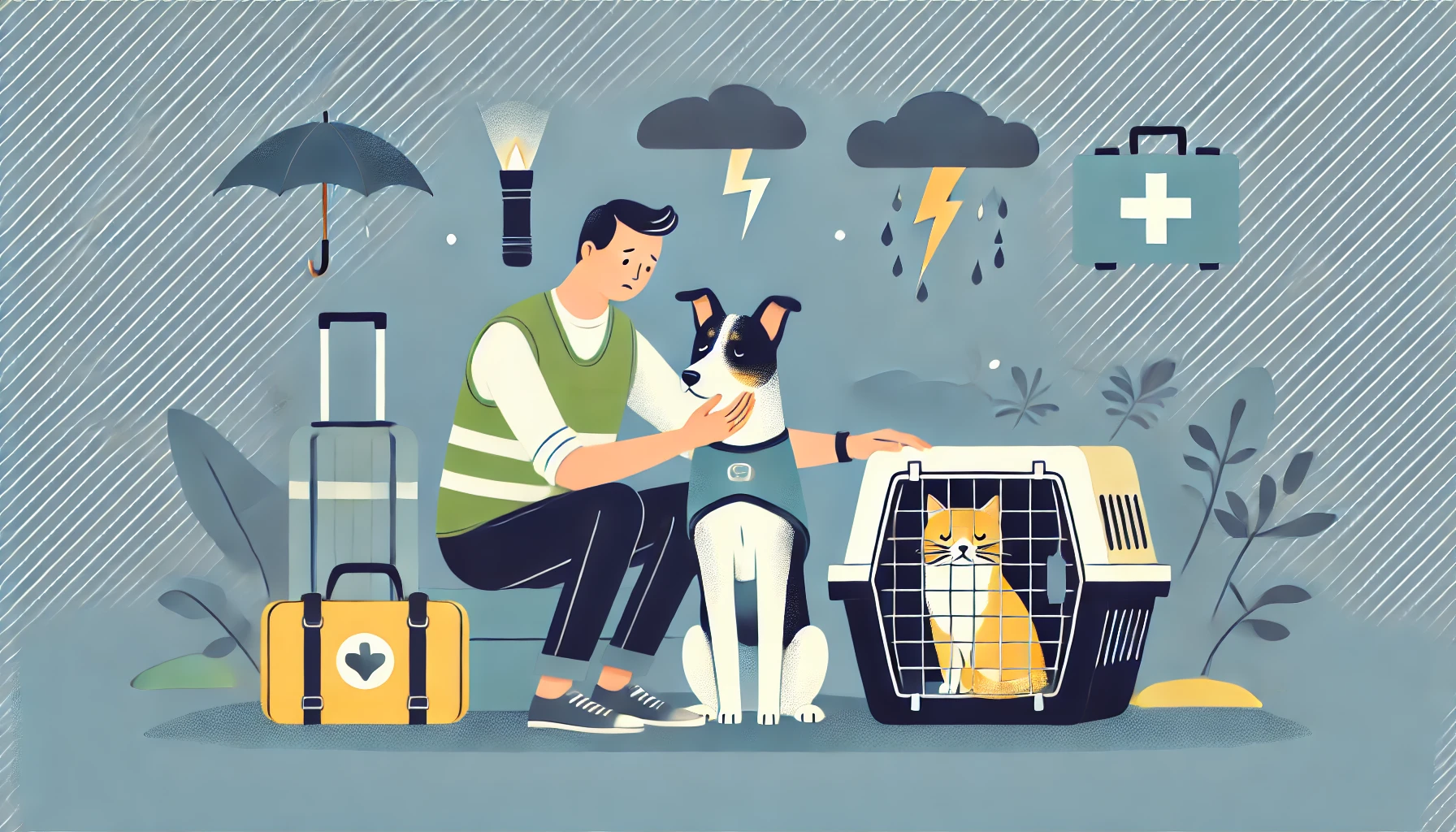Natural disasters and severe storms can be frightening and disruptive for pets, who often rely on routine and stability. Preparing ahead of time is key to ensuring their safety and comfort during these emergencies. This guide will help you protect your furry friends and reduce their stress during storms and natural disasters.
Understanding the Risks
Natural disasters, such as hurricanes, earthquakes, floods, wildfires, and severe storms, can put pets at risk of injury, stress, and separation.
Why Pets Are Vulnerable
- Heightened Senses: Pets often detect storms or natural disasters before humans, leading to anxiety.
- Limited Awareness: Pets don’t understand the dangers, increasing their likelihood of fleeing or hiding in unsafe places.
- Dependence on Humans: They rely on you for guidance and protection during emergencies.
Pre-Disaster Preparation
Preparation is the most important step in keeping pets safe during emergencies.
Assemble a Pet Emergency Kit
A well-stocked emergency kit ensures your pet’s needs are met during and after a disaster. Include:
- Food and Water: Pack a 3–7 day supply of non-perishable pet food and bottled water.
- Medications: Include a supply of any necessary medications with instructions for use.
- Identification: A recent photo, vaccination records, and a copy of your pet’s microchip information.
- Comfort Items: Add a favorite toy, blanket, or bed to help ease stress.
- Sanitation Supplies: Include waste bags for dogs and a portable litter box for cats.
- First-Aid Kit: Bandages, antiseptic wipes, a pet thermometer, and tweezers for injuries.
Prepare Your Home
Ensure your home is ready to shelter pets during a disaster.
- Safe Rooms: Designate a secure, quiet area where pets can stay during storms. Choose rooms without windows, such as a bathroom or basement.
- Pet-Proofing: Remove hazards, such as sharp objects, toxic substances, or unstable furniture.
- Soundproofing: Use rugs, heavy curtains, or blankets to minimize noise and vibrations.
Identify Pet-Friendly Shelters
In case of evacuation, research shelters or hotels that accept pets.
- Locate Pet Shelters: Many emergency shelters do not allow pets, so identify nearby pet-friendly facilities.
- Create a Contact List: Keep phone numbers for veterinarians, animal control, and nearby friends or family who can assist during emergencies.
Train Your Pet for Emergencies
Familiarize your pet with the process of evacuations and emergency situations.
- Carrier Training: Teach your pet to enter a crate or carrier willingly.
- Leash and Harness Practice: Ensure your dog or cat is comfortable with a leash and harness for safe transport.
During a Storm or Disaster
When the disaster strikes, keeping calm and following a plan ensures your pet’s safety.
Keep Pets Indoors
- Bring pets inside well before the storm begins to prevent them from fleeing or being exposed to dangerous conditions.
- Close all windows and secure doors to keep pets from escaping.
Provide a Safe Space
- Place your pet in their designated safe room or crate with familiar items to comfort them.
- Play calming music or white noise to drown out external sounds.
Monitor Their Behavior
Pay attention to signs of stress or anxiety, such as pacing, excessive panting, or hiding.
- Offer Comfort: Sit with them, speak in a soothing voice, and provide gentle petting if they seek reassurance.
- Provide Distractions: Use toys, treats, or interactive puzzles to keep them occupied.
During Evacuations
If evacuation becomes necessary, take your pets with you—never leave them behind.
Prepare for Transport
- Use a secure carrier or crate for cats and small dogs.
- For larger dogs, ensure their leash and harness are secure.
Stick to Essentials
- Bring your emergency kit and ensure all items are easily accessible.
- Keep your pet’s identification tags and microchip information up to date.
Keep Pets Calm During Travel
- Cover crates with a light blanket to reduce visual stressors.
- Stop frequently to allow pets to stretch, hydrate, and relieve themselves.
After the Storm or Disaster
The aftermath of a disaster can be equally stressful for pets.
Inspect Your Home
Before allowing pets to roam freely, check for hazards such as broken glass, exposed wires, or flooding.
Monitor Your Pet’s Health
Watch for signs of stress, injury, or illness in the days following the disaster.
- Behavioral Changes: Increased anxiety, aggression, or hiding.
- Physical Symptoms: Vomiting, diarrhea, or limping.
- Consult your veterinarian if any issues arise.
Reestablish Routine
Return to your pet’s normal feeding, walking, and play schedule as soon as possible to provide stability.
Tips for Specific Disasters
Floods
- Never leave pets in a flooded area or let them drink floodwater, which may be contaminated.
- Move pets to higher ground and keep them confined in safe spaces.
Wildfires
- Prepare for rapid evacuations by keeping carriers and leashes near the door.
- Protect pets from smoke inhalation by keeping them indoors with filtered air.
Earthquakes
- After an earthquake, check for injuries and keep pets indoors to avoid aftershocks.
- Inspect fences or enclosures for damage before letting pets outside.
Hurricanes and Tornadoes
- During strong winds, secure pets in a safe room or crate.
- Have leashes and carriers ready in case of sudden evacuation orders.
Conclusion
Keeping your pets safe during storms and natural disasters requires preparation, vigilance, and compassion. By creating an emergency kit, planning for evacuations, and understanding your pet’s needs, you can protect them from harm and reduce their stress during these challenging events. With thoughtful planning and care, you can ensure your furry friends remain safe and loved no matter what nature brings.

